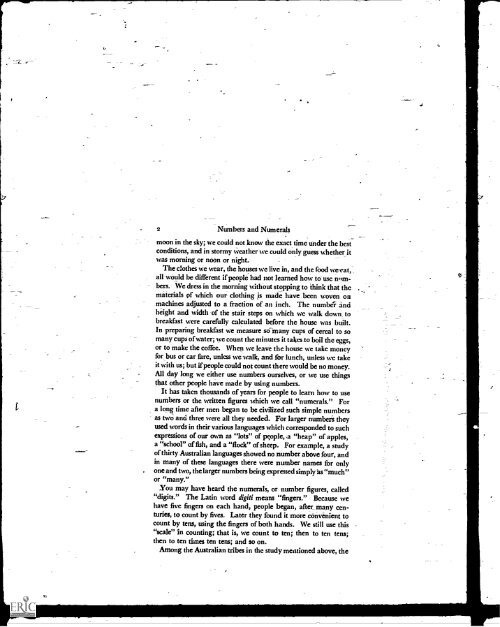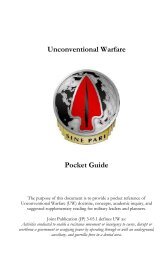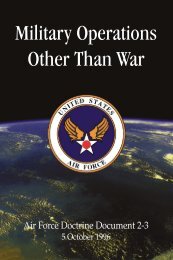ED077712
ED077712
ED077712
Create successful ePaper yourself
Turn your PDF publications into a flip-book with our unique Google optimized e-Paper software.
2 Numbers and Numerals<br />
moon in the sky; we could not know the exact time under the best<br />
conditions, and in stormy weather we could only guess whether it<br />
was morning or noon or night.<br />
The clothes we wear, the houses we live in, and the foodwevat,<br />
all would be different if people had not learned how to use trimbers.<br />
We dress in the morning without stopping to think that the<br />
materials of which our clothing is made have been woven on<br />
machines adjusted to a fraction of an inch. The numbel and<br />
height and width of the stair steps on which we walk down, to<br />
breakfast were carefully calculated before the house was built.<br />
In preparing breakfast we measure so many cups of cereal to so<br />
many cups of water; we count the minutes it takes to boil the eggs,<br />
or to make the coffee. When we leave the house we take money<br />
for bus or car fare, unless we walk, and for lunch, unless we take<br />
it with us; but ifpeople could not count there would be no money.<br />
All day long we either use numbers ourselves, or we use things<br />
that other people have made by using numbers.<br />
It has taken thousands of years for people to learn how to use<br />
numbers or the written figures which we call "numerals." For<br />
a long time after men began to be civilized such simple numbers<br />
as two and three were all they needed. For larger number's they<br />
used words in their various languages which corresponded to such<br />
expressions of our own as "lots" of people, =a "heap" of apples,<br />
a "school" of fish, and a "flock" of sheep. For example, a study<br />
of thirty Australian languages showed no number above four, and<br />
in many of these languages there were number names for only<br />
one and two, the larger numbers being expressed simply is " much"<br />
or "many."<br />
You may have heard the numerals, or number figures, called<br />
"digits." The Latin word digiti means "fingers." Because we<br />
have five fingers on each hand, people began, after many centuries,<br />
to count by fives. Later they found it more convenient to<br />
count by tens, using the fingers of both hands. We still use this<br />
"scale" in counting; that is, we count to ten; then to ten tens;<br />
then to ten times ten tens; and so on.<br />
Among the Australian tribes in the study mentioned above, the





